The Hoka and Brooks Running brands have been designing fantastic running shoes over the last few years; I know this because I test a scary amount of running shoes each year but it’s these two brands that manage to consistently produce the majority of the high ranking shoes that I ultimately end up recommending to our readers.
Both brands have loyal followings and a reputation for producing high-quality running shoes and I’ve been running in and reviewing shoes from both brands for years right here on the Trail & Kale Running blog and also our Youtube Channel, so I’m excited to share my insights with you in this Hoka VS Brooks comparison article which will help you choose which one to go for.
Whether you’re a road runner, trail runner, or just looking for something comfortable to wear all day, this post will give you all the information you need to decide which brand will be best suited to you – and if you’re still not sure, just let me know your specifics, and I’ll get you hooked up with the best shoes for you.

In this article I explain the key differences and similarities between Hoka and Brooks, highlighting their strengths (and weaknesses) and which models excel for various types of running. Spoiler alert: you might find that you’ll want to have shoes from both brands in your rotation, just like I do.
More popular HOKA and Brooks buying guides:
- The Best HOKA Running Shoes
- The Best Brooks Running Shoes
- HOKA VS On Cloud Running Shoes
- The Best HOKA Shoes For Walking
- HOKA Shoe Reviews
- Brooks Shoe Reviews
A brief overview of the Hoka and Brooks Running brands
Hoka originally took the running world by storm with its maximalist cushioned shoes but now produce everything from daily trainers to race day carbon plate running shoes, and plenty of awesome trail running shoes too. Founded in 2009, Hoka set out to revolutionize running shoes by prioritizing comfort and cushioning. This design philosophy has made Hoka a favorite among long-distance runners and those who need extra support.
Beyond cushioning, Hoka is also known for its innovative technologies, such as the Early Stage Meta-Rocker geometry, which promotes a smooth rolling motion, and the ProFly midsole, offering a blend of soft landings and responsive toe-offs. Their vibrant and bold designs cater to runners who want their shoes to make a statement, though they also offer more muted color options.
Brooks, on the other hand, is a stalwart in the running shoe industry with a history dating back to 1914. The American brand, based in Seattle, Washington, has been dedicated to crafting running shoes since its pivot to the running niche in 2001. Brooks is renowned for its balanced approach to cushioning and support, making their shoes incredibly versatile and suitable for a wide range of runners.
Technologies like DNA LOFT midsole foam, which offers plush cushioning and response, and GuideRails, which provides holistic support to keep excess pronation in check, are just a couple of examples of Brooks’ contributions to running shoe innovation. Their shoes are affordable, while still performing exceptionally well with high build quality.
What are the main differences between Brooks and Hoka running shoes?
For the most part, Hoka shoes are instantly recognizable due to their maximalist cushioning and high stack heights.

The thick midsoles, provide an incredibly soft and plush ride, making Hoka a go-to for runners seeking maximum comfort for absorbing the impact of long-distance runs, and reducing strain on your joints and muscles.
Visually, Hoka running shoes tend to be very bold and vibrant, which I personally love because they add a bit of flair and fun to my runs. However, for those who prefer a more subtle look, they also offer more muted tones.
In contrast, Brooks shoes tend to have a more traditional design, focusing on a balance of style, functionality, and affordability.
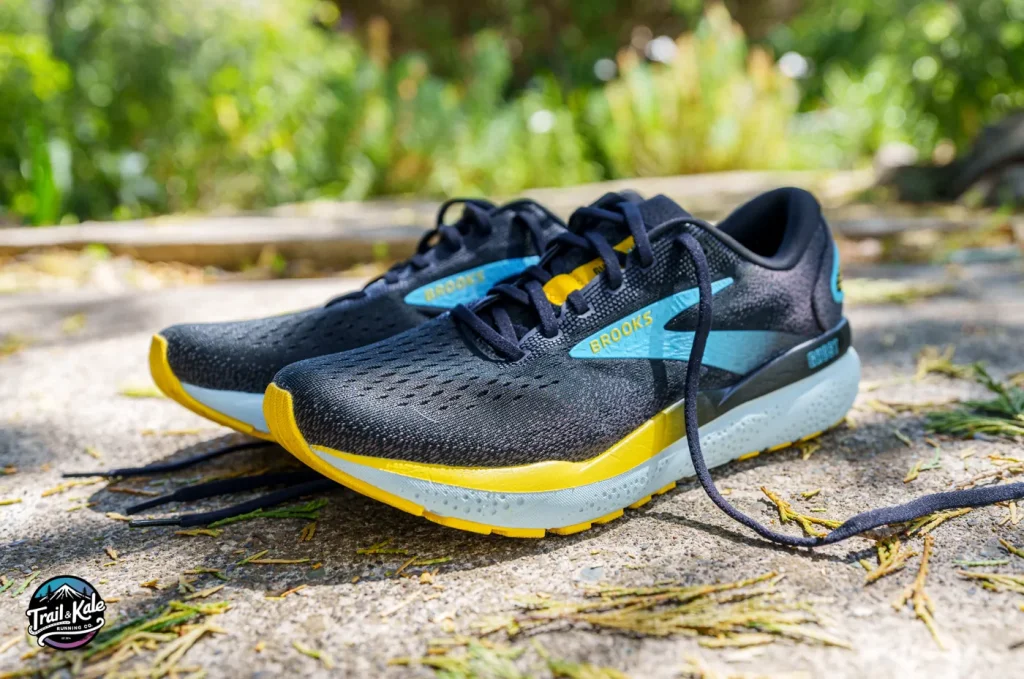
While they don’t have the same maximalist look as Hoka (the Ghost Max being an exception), Brooks running shoes are known for their, for want of a better word, ‘sensible’ appearance. They are designed to look and feel versatile, making them suitable for a variety of running environments but also daily lifestyle wear.
Brooks offers a wide range of colors, but their palette is generally more understated compared to Hoka. This makes their shoes a great choice for runners who appreciate a classic and timeless look. Despite their more traditional design, Brooks shoes are packed with innovative technology aimed at enhancing performance and comfort on the run.
How does the fit and feel compare between HOKA and Brooks?
Both Hoka and Brooks prioritize comfort and support, but they achieve it in different ways and both tend to be extremely comfortable right out the box and while they both for the most part, consistently have neutral support and a medium width, Brooks also have their own GTS or ‘Go-To Support’ stability versions of some of their most popular running shoes.
Some of the more popular models even offer wide and narrow versions for those who need it! Visit my ‘Best Brooks Running Shoes‘ or ‘Best HOKA Running Shoes‘ guides to find out which models offer wide versions – or if you have wide feet and just want to know the best from every brand, visit my Best Running Shoes For Wide Feet roundup.
Hoka fit and feel
Hoka shoes are renowned for their exceptional cushioning, which makes them incredibly comfortable to run in. The high stack heights and plush midsoles create a soft, cushioned feel that’s perfect for long-distance running and recovery runs. Then there’s the Meta-Rocker technology in Hoka shoes that promotes a smooth and efficient rolling motion from heel to toe, reducing the energy expenditure in each stride – and making it easier to run faster, for longer.
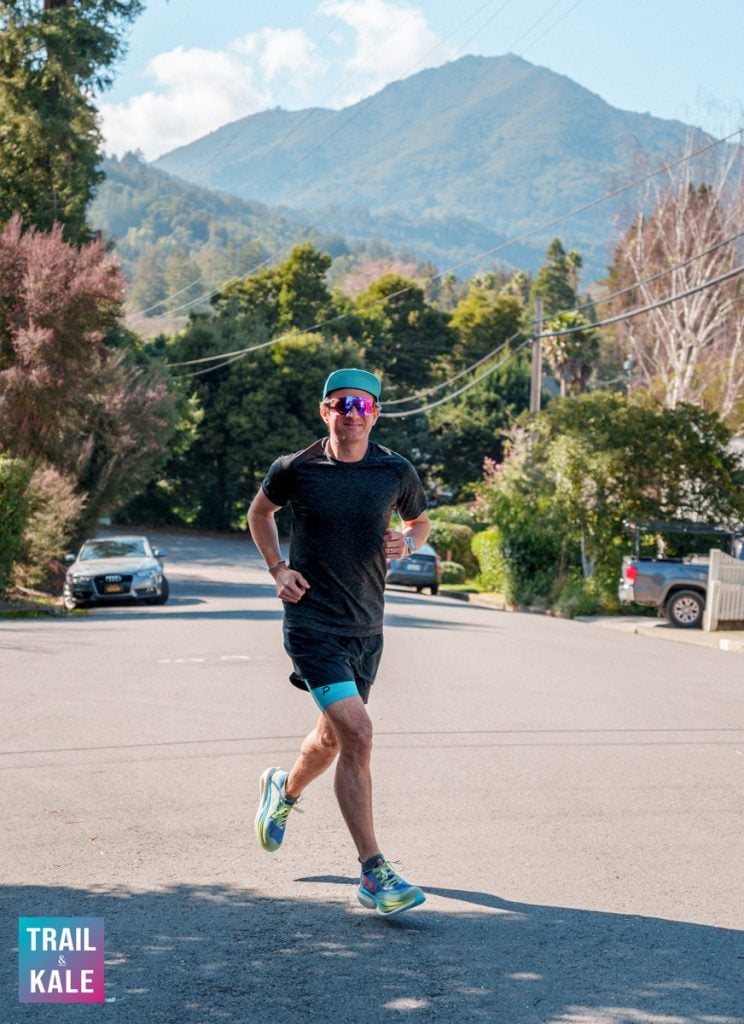
Hoka shoes typically have a neutral support structure, and relatively low drop of around the 5mm mark, which works well for a wide range of runners and promotes running with proper biomechanics. They are also available in various widths, including narrow and wide options, ensuring a good fit for different foot shapes. One thing to note is that Hoka’s high stack heights might take a bit of getting used to if you’re accustomed to more minimalist shoes. However, once you adapt, you’ll likely appreciate the added comfort and reduced impact on your joints.
Hoka also produces running shoes with thinner, more responsive midsoles too, for runners looking for ways to run faster, like the Mach 6 for example which is a top tempo and speed work running shoe, and the carbon fiber plated Cielo X1 which is a total speed demon when it comes to racing and interval training.
Brooks fit and feel
Brooks shoes are designed to offer a balanced combination of cushioning and responsiveness. The DNA LOFT cushioning provides a soft yet springy feel, making their shoes versatile for different types of runs, from daily training to tempo runs, and even trail running on technical trails.
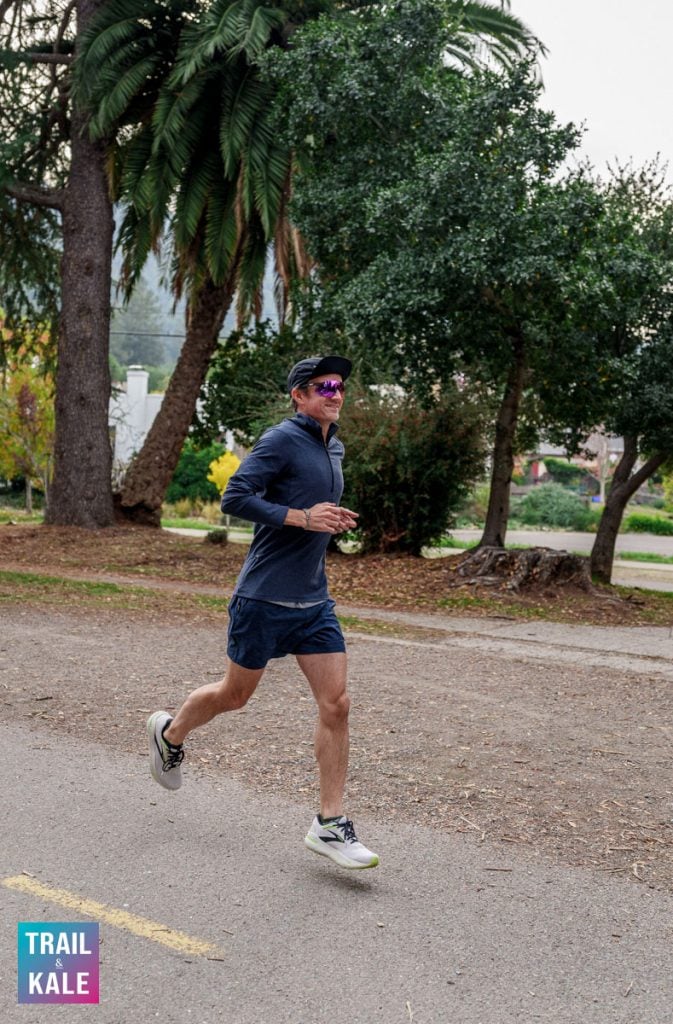
Brooks also incorporates their GuideRails technology in many models, which helps to keep your feet, knees, and hips aligned, reducing the risk of injury by controlling excess lateral movement.
Brooks shoes, like Hoka, generally fit true to size and are known for their comfortable fit straight out of the box. They offer a medium width as standard, but many models are available in wide and narrow versions to accommodate different foot shapes. The fit of Brooks shoes is designed to provide a secure yet flexible feel, with enough room in the toe box to allow for natural foot movement without being too loose.
Both brands have the right shoe for your run; here are my top HOKA VS Brooks picks for various running disciplines
HOKA and Brooks both have special offerings whether you’re training to run faster, putting in quality tempo miles, or planning to run longer by stepping into the world of marathon training and ultra endurance events.
For a full breakdown of the best Brooks and HOKA running shoes visit the posts below:
Below are some examples of the types of running you may be into (or the type of shoe you like), and my top picks for each run type from HOKA and Brooks:
Everyday running, including daily jogs and recovery runs

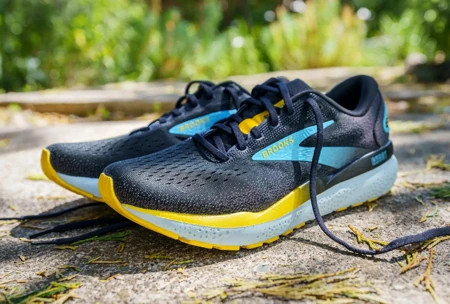
Every running brand has an entry level running shoe that’s either targeted at beginner runners, or those who want a reliable daily trainer that helps you bag easy miles and doesn’t break the bank.
Here are my top picks for HOKA and Brooks:
- HOKA’s top daily trainer: Clifton 9 | read review
- Brooks’ top daily trainer: Ghost 16 | read review
➡ I hope you’re enjoying reading this HOKA VS Brooks comparison post; as always, please share your own thoughts and experiences in the comments down below and if you enjoyed this post or our blog in general, subscribe to our Newsletter to stay up to date on all the latest and greatest running gear! 🏃♂️💚
Join our Strava club too, and be part of the joy that running brings to our lives.
Tempo training and speed work


Ah, the art of the tempo run; fast but not too fast, right? These shoes offer a blend of cushioning and responsiveness that can help you maintain that tricky “comfortably hard” pace during your next tempo training run, or interval sessions.
- HOKA’s top tempo shoe: Mach X | read review
- Brooks’ top tempo shoe: Hyperion Max | read review
Marathon training / Long runs (max cushion)


Marathon training, as you would expect, involves a lot of mileage which means you need a running shoe that is cushioned but also has enough responsiveness to help you keep your speed up, here are my top picks for this type of running shoe.
- HOKA’s top marathon training shoe: Clifton 9 | read review
- Brooks’ top marathon training shoe: Ghost Max | read review
Race day super shoes for 5km to Marathons / interval training


Now we’re talking endurance and PR speed, combined! With racing from 5km to marathons, you want something that can go the distance without feeling like you’re lugging around bricks on your feet – and that requires a pair of carbon plate running shoes.
These are the top choice for any distance race day too, in fact I recently set a new PR in the 5k distance using the Cielo X1, and my previous record stood for over 8 years!
Here are my top picks for runners looking to get a new Personal Best time at their next marathon race:
- HOKA’s top marathon racer: Cielo X1 | read review
- Brooks’ top marathon racer: Hyperion Elite 4 | read review
Trail running & ultra running
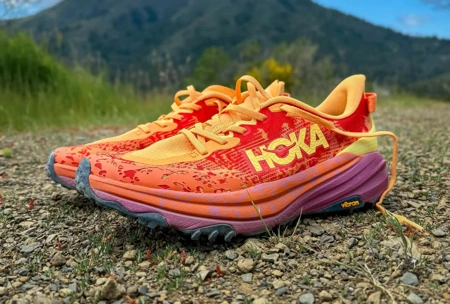
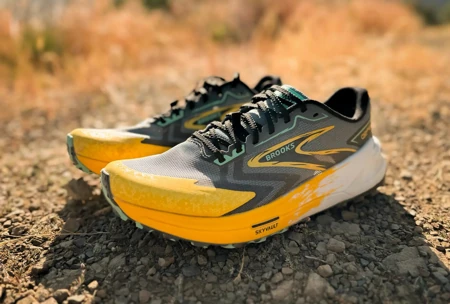
If you’re hitting the trails, you need something that’s cushioned (for comfort over ultra running distances and long time periods), is responsive for speed and control, grips like a mountain goat, and provides control and stability on a mixture of different surfaces – us trail runners don’t ask for much, do we?! haha! Here are my top picks for trail running:
- HOKA’s top trail running shoe: Speedgoat 5 | read review
- Brooks’ top trail running: Catamount 3 | read review
So, there you have it, whether you’re sprinting, cruising, or going the ultra distance, Hoka and Brooks both have got you covered, and all my shoe testing over the years has led me to be able to provide you with these shoe recommendations for each case.
I hope those top picks helped narrow down the best choice options for you, but if I missed the type of running you enjoy, or you have more specific needs, please just ask me anything in the comments below; I love chatting about Brooks and HOKA running shoes. 🙂
Let’s compare HOKA VS Brooks running technologies
Now for the extra nerdy part of this comparison! HOKA and Brooks both have their own proprietary technologies but each are comparable to one another, if you know what to look for when chopping through the marketing jargon.
So, in this section I’m going to do my best to explain the matching technologies for both brands, and let you know whether HOKA or Brooks is best in each area.
1. GlideRoll Rocker VS Meta-Rocker geometry
What is a rocker anyway? In simple terms, it’s a curved shape in the shoe’s sole that promotes a rolling motion as your foot hits the ground and pushes off again.
Imagine a rocking chair, now, translate that curved, rocking base to the bottom of your shoe – that’s your rocker!
Why does It matter?
The rocker’s primary job is to help with what we runners care about most: efficient energy transfer in your stride from heel/midfoot strike to toe off.
When your foot rolls smoothly from heel to toe, you’re not just getting a smoother stride; you’re also conserving energy, which is golden whether you’re doing a quick 5K or grinding out a marathon or ultramarathon.
Types of rockers
You’ll often see two main types:
- Forefoot Rocker: This one’s situated at the front of the shoe, helping to push you off more efficiently on toe-off. Great for up-tempo runs or races.
- Heel-to-Toe Rocker: This runs the full length of the shoe, helping guide your foot through the entire stride cycle. Super helpful for long distances and easy runs.
Brands like Hoka are known for incorporating this feature heavily in their shoe designs. It’s one reason why they’re popular for long runs and marathons. But many other brands, including Brooks Running, are also starting to add rockers to their models for that extra oomph in your stride, one such model being the Ghost Max, pictured below.
Here are 2 great examples of rocker geometries from each brand:
On the left is the Brooks Ghost Max, sporting a forefoot rocker, and on the right is the Cielo X1 sporting a clearly defined extreme rocker, designed to encourage pure speed.

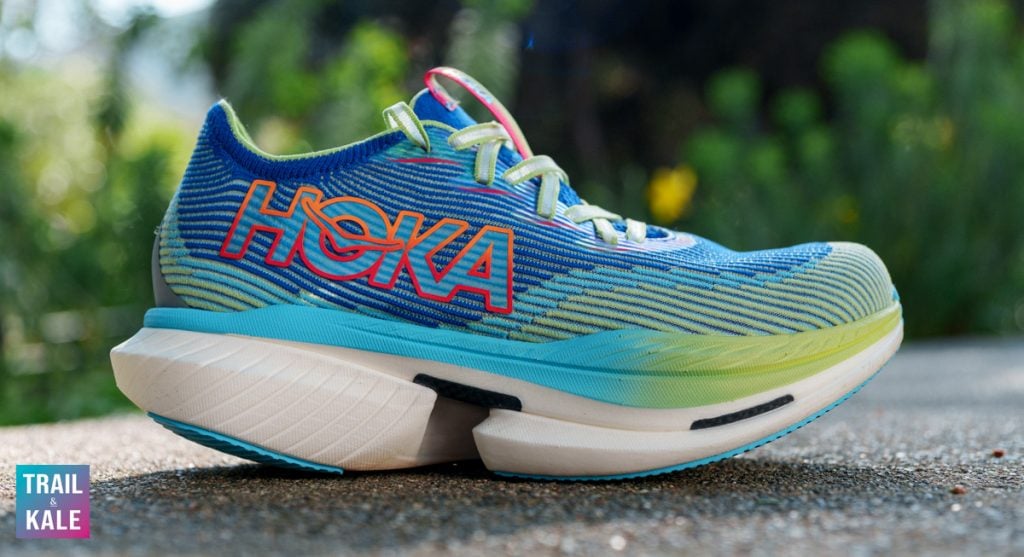
Both brands have their own names for their version of a rocker silhouette. HOKA calls theirs the Meta-Rocker, available on some running shoes as an early stage meta-rocker (like the Rocket X 2) and others as a late stage meta-rocker.
The difference between the two types of rockers is where along the bottom of the foot, the rocker begins; and this affects how efficient the stride is when you’re running at different speeds.
For example a faster runner with more of a forefoot landing will benefit from an early stage meta-rocker, whereas maybe a heavier runner with more of a heel strike will benefit more from a late stage rocker.
Brooks calls their rocker, …the ‘GlideRoll’ rocker and it does a good job but not as extreme as HOKA’s meta rocker, so I’m going to give Hoka this win!
2. Brooks’ DNA LOFT v3 and DNA Flash midsole VS HOKA’s ProFly midsole
The midsole in any running shoe is an important factor in terms of how successful your training is going to be with the shoes. It’s responsible for cushioning, responsiveness, longevity of cushioned response, and to some degree the stability of your ride.
Sometimes they even have a carbon or PEBAX plate running through it to help propel you forward even faster, both brands offer fast carbon plate running shoes too; great examples include the Brooks Hyperion Elite 4, Cielo X1 and the HOKA Rocket X 2.
Brooks’ DNA LOFT v3 and DNA Flash midsole (The also have BioMoGo DNA and DNA Amp foams)
- DNA LOFT v3 (their most popular foam): By infusing the cushion with nitrogen and using large-cell foaming, they’ve made it softer, lighter, and more responsive. This means you get a more comfortable and bouncy ride without losing any of the durability that Brooks is known for.
- DNA FLASH v2: This nitrogen-infused foam provides a blend of energy return and lightweight feel. It adapts to your unique stride, making it easier to achieve your natural speed with every run.
Below are examples of Brooks’ DNA LOFT v3 and HOKA’s ProFlyX midsoles:

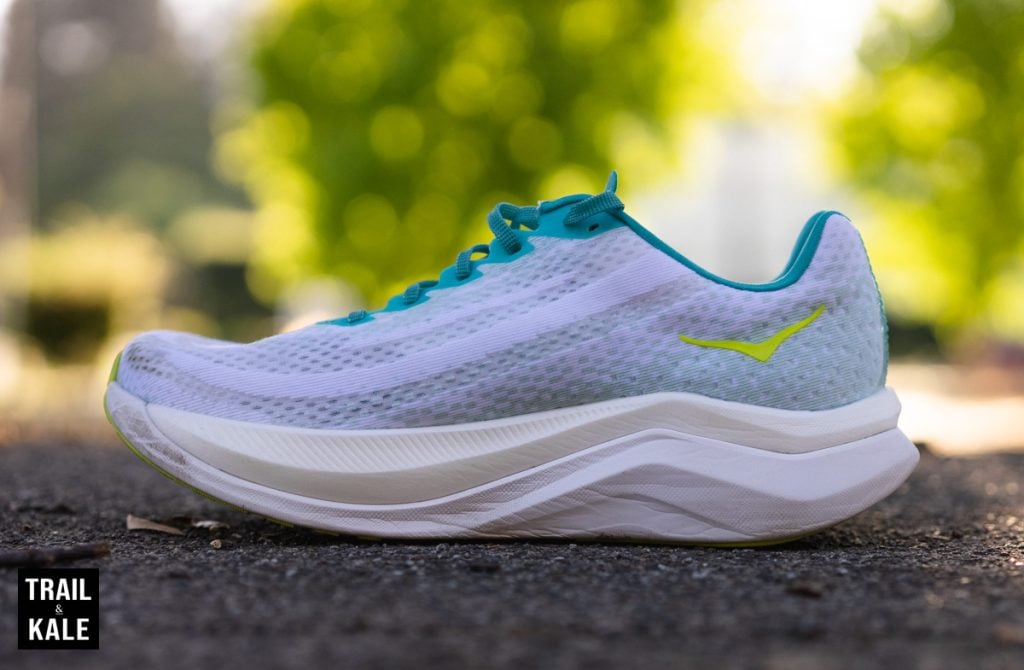
HOKA’s PROFLY Midsole: What’s the hype?
HOKA’s PROFLY is a dual-density midsole that features softer foam at the heel and firmer foam in the forefoot. This tech is all about a cushioned landing and a responsive toe-off.
If you’re eyeing a marathon race, or even just long weekend runs, PROFLY offers that marshmallow-like comfort and bounce we all crave.
Carbon Plates
I’m sure you’ve heard of carbon plates in running shoes, it’s part of how marathon runners are able to break so many records of late – that and and all their countless hours and dedication to their training of course.
Well both brands have racing shoes that feature carbon fiber plates – Hoka certainly has more options there however.
HOKA uses carbon more frequently in their more premium shoe midsoles, infact all models containing X in their names, that include shoes like the Cielo X1, Carbon X3, Tecton X 2, Mach X, etc.
Brooks right now are using technologies such as the ARRIS carbon plate, which is a pretty cool, unique technology in the industry, and used on their super shoe, the Hyperion Elite 4.
I’m going to give this win to HOKA as they offer more shoes with carbon plates, including the Tecton X 2 in their trail running shoe range. The Brooks Catamount 3 does also have a plate but it’s not carbon (which actually has it’s pros and cons).
How does a carbon plate work?
For those not familiar here’s a really quick lesson in how carbon fiber plates work. Picture a thin, curved carbon fiber plate sandwiched between layers of cushioning in the midsole of your running shoe.
This isn’t just there for show (because most of the time it’s actually hidden!) or to bump up the price tag (although that’s exactly what it does, lol); it serves a very functional purpose. When you run, the carbon plate acts like a lever, storing energy as your foot lands and then springing it back as you push off.
It also improves your running economy, definitely not in the dollars-and-cents kind of way, but in terms of how efficiently you use oxygen while running. The carbon plate can help you run faster for the same level of effort, which is golden whether you’re tackling a quick 5K or grinding out a marathon.
NOTE: Carbon-plated shoes aren’t a magic bullet; they won’t instantly turn you into Eliud Kipchoge, and they might not be the best for everyone’s biomechanics or for softer trails (if you have one in your trail running shoes).
But if you’re keen on shaving off those seconds (or minutes) from your PR, they are worth checking out. Just prepare your wallet; the future of running doesn’t come cheap!
Brooks TrailTack VS Vibram MegaGrip outsole use on many HOKA trail running shoes
This is the technical term that each brand gives their outsole rubber compound. Brooks TrailTack outsole is incredibly impressive and performed just as well as Vibram Megagrip in dry conditions, I’m stuill waiting for it to rain in California so I can test this rubber compound in the wet.
Vibram’s MegaGrip rubber compound with Traction Lug formation is best in class right now for both technical terrain and in dry or wet conditions but I suspect TrailTack will also be great in the wet – Brooks know what they’re doing with wet trails as their design and test team is based out of Seattle in the Pacific Northwest.
Here are examples of Brooks’ TrailTack Green (The ‘Green’ version uses 25% recycled materials) outsole and HOKA’s use of Vibram’s MegaGrip with Traction Lugs outsole:


There’s a reason trail running shoes from other brands like the Arctery’x Sylan, Merrell MTL Long Sky 2 Matryx, Nike Zegama 2, and the Dynafit Ultra 100 both choose Vibram Megagrip – it’s damn good, and has kept me upright on so many occasions where other outsoles just wouldn’t have.
A reliable and trustworthy outsole that you can rely on to give you grip and control is incredibly important while trail running, not only does it open up the trail, giving you more potential foot landing positions but it also gives you confidence to run more aggressively on challenging descents and steep ascents that require you to claw into the trail to maintain vertical speed.
You guessed it, HOKA wins in the outsole realm but to be honest, there’s not much in it now Brooks has their incredibly grippy TrailTack compound.
Do cushioned running shoes hurt or help, and what’s the alternative?
For completeness, let’s address a topic that has the running community divided: cushioned running shoes and whether they’re a benefit or a hindrance, and what the alternative is.
Why Cushioning Could Be Your Best Friend
Cushioning in running shoes like HOKA or Brooks can be very beneficial if you experience joint or muscle pain. The extra padding absorbs shock, protecting sensitive areas and making your run pain-free. For long-distance runners, cushioned shoes offer comfort, which is crucial during marathons or ultramarathons. Additionally, cushioning acts as a buffer for those prone to stress fractures or other impact-related injuries, providing a softer landing.
Why Highly Cushioned Shoes May Not Be for You
However, highly cushioned shoes aren’t going to be for everyone, if you enjoy feeling every nuance of the trail or road, cushioning can dull this connection, potentially affecting your proprioception and stability, which can lead to clumsiness or tripping on the trail. Excessive cushioning and high stack heights can also promote bad form, such as increased heel striking, which may lead to injuries over time.
Shoes with less cushioning are typically more responsive, though they might be less comfortable over long distances or rough terrains. The key is finding a balance that offers enough cushioning without compromising responsiveness.
There are of course running shoes that strike this balance, and when a shoe like that comes along, with a breathable upper that also hugs your feet in a comforting and supportive way, well… that’s when you’ve got yourself a winner in my opinion.
For road running, this shoe for me is the Brooks Ghost Max, and for trail running it’s the HOKA Speedgoat 6.
HOKA vs Brooks differences in price
HOKA and Brooks both have an average shoe price of around $150 when you look at their whole range.
When it comes to pricing, both HOKA and Brooks Running shoes are reasonably priced when you look at some other more expensive brand like On, for example.

HOKA tends to start at a slightly higher base price, with many of their popular models like the Clifton and Bondi hovering around $130-$160. Their specialized trail shoes and carbon-plated racers can go up to $250 or more.
On the other hand, the Brooks lineup has a broader range when it comes to price. You’ve got options from around $100 like the Launch 10 (my top recommendation for best running shoe on a budget) going up to the premium race day shoe Hyperion Elite 4 at $250.
The price of each shoe can also reflect the type of running experience you’re after. HOKA is renowned for their excellent cushioning, which is perfect for long runs and recovery days, and even for standing on your feet/walking all day.
If you’re clocking ultra distances or just want to feel like you’re running on clouds, then HOKA might be your go-to even at a slightly higher base price as I feel like you’re potentially getting better value for money in their durability and versatility.
Brooks running shoes are generally designed for a responsive ride and a different kind of underfoot feel, which many people swear by, myself included.
If you made it all the way to this point then hopefully you enjoyed reading this HOKA VS Brooks roundup, and if you did, you can now consider yourself a bit of an expert in both brands! 🙂
Thanks for reading, please share this guide with a friend who also loves HOKA and Brooks running shoes, and subscribe to our Newsletter for the best running content on the web! -Alastair

![The Best Trail Running Shoes [2024] The Best Trail Running Shoes [2024]](https://www.trailandkale.com/wp-content/uploads/2024/02/best-trail-running-shoes-Trail-and-Kale-Recommends-2024-110x75.webp)


![The Best Running Shoes [2024] The Best Running Shoes [2024]](https://www.trailandkale.com/wp-content/uploads/2024/02/best-running-shoes-Trail-and-Kale-Recommends-2024-alt-image-4-110x75.webp)



